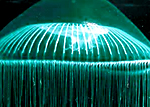
|
Cyan fluorescent protein TagCFP
- Bright cyan fluorescence
- Monomeric protein with successful performance in fusions
- Fast maturation, high pH-stability and photostability
- Proven suitability to generate stably transfected cell lines
- Recommended for protein labeling
 |
TagCFP is a cyan monomeric protein generated on the basis of the wild-type GFP-like protein from jellyfish Aequorea macrodactyla [Xia et al., 2002]. It possesses bright fluorescence with excitation/emission maxima at 458 and 480 nm, respectively. TagCFP is significantly brighter than commonly used ECFP.
TagCFP is mainly intended for protein labeling in protein localization and interaction studies. It can also be used for cell and organelle labeling and for tracking the promoter activity.
|
Related products| PRODUCT | CAT.# | DESCRIPTION | SIZE | PRICE | *50% discount on the second and subsequent vectors encoding same fluorescent protein or sensor ordered by the same customer.
The prices do not include delivery. The prices vary in different countries. Please contact your local distributor for exact prices and delivery information. |
|
| TagCFP expression/source vectors |
|
|
|---|
| pTagCFP-actin |
FP114 |
Mammalian expression vector encoding humanized TagCFP fused with human cytoplasmic β-actin |
20 μg |
€ 400 / 200* |
|
| Antibody against TagCFP |
|
|
|---|
Anti-Tag(CGY)FP
antibody |
AB121 |
Rabbit polyclonal antibody against TagCFP, TagGFP, TagGFP2, TagYFP, PS-CFP2, Case12, HyPer, EGFP, BrUSLEE and SLIM |
100 μg |
€ 220 |
References:
-
Xia NS, Luo WX, Zhang J, Xie XY, Yang HJ, Li SW, Chen M, Ng MH.
Bioluminescence of Aequorea macrodactyla, a common jellyfish species in the East China Sea.
Mar Biotechnol (NY). 2002; 4 (2):155-62. / pmid: 14961275
|





